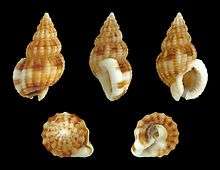Tritia incrassata
| Tritia incrassata | |
|---|---|
 | |
| Scientific classification | |
| Kingdom: | Animalia |
| Phylum: | Mollusca |
| Class: | Gastropoda |
| (unranked): | clade Caenogastropoda clade Hypsogastropoda clade Neogastropoda |
| Superfamily: | Buccinoidea |
| Family: | Nassariidae |
| Subfamily: | Nassariinae |
| Genus: | Tritia |
| Species: | T. incrassata |
| Binomial name | |
| Tritia incrassata (Ström, 1768)[1] | |
| Synonyms[2] | |
| |
Tritia incrassata, common name the thick-lipped dogwhelk, is a species of sea snail, a marine gastropod mollusk in the family Nassariidae, the Nassa mud snails or dog whelks.[2]
Description
The shell up to 15 mm high with rather high spire and a rounded body whorl. The protoconch is small, distinctly cyrtoconoid with 2.5 smooth whorls. The teleoconch contains 6-7 convex whorls, with a sculpture of regular spiral cords, broader than the interspaces. Its axial folds become distinctly flexuous on the body whorl. The aperture is bordered externally with a strong varix forming a rim, normally unique - not repeated at the earlier growth stages on the spire. The inner side of the outer lip bears ca. 10 denticles, elongated in the spiral direction. The parietal edge of the aperture forms a very thin, appressed callus, with a distinct adapical denticle, continued into a thicker columellar callus with a slightly raised edge. The base of the body whorl has a groove delimiting the outer part of the siphonal canal.
The colour of the shell is extremely variable, with distinct combinations of brown, black, yellowish or orange hues, most often with a paler band on abapical part of spire whorls and periphery of body whorls. Elsewhere it is arranged in bands or in spiral series of blotches, or uniform. The aperture is white with a highly diagnostic black blotch inside the siphonal canal.[2]
Distribution
This species occurs in European waters, throughout the Mediterranean Sea and the Eastern Atlantic Ocean (from Norway to southern Morocco, also off the Canary Is. and the Azores) at depths between the shoreline to ca. 100 m.
References
- ↑ [http://www-gdz.sub.uni-goettingen.de/cgi-bin/digbib.cgi?PPN481641912_0004 Ström H. (1768). Beskrivelse over Norske Insecter. Andet Stykke. Det Kongelige Norske Videnskabers Selskabs Skrifter, Kjobenhavn : 4: 313-371, pl. 16]. World Register of Marine Species, Retrieved 18 April 2010.
- 1 2 3 Marshall, B. (2016). Tritia incrassata (Strøm, 1768). Accessed through: World Register of Marine Species at http://www.marinespecies.org/aphia.php?p=taxdetails&id=876825 on 2016-05-18
- Cernohorsky W. O. (1984). Systematics of the family Nassariidae (Mollusca: Gastropoda). Bulletin of the Auckland Institute and Museum 14: 1-356.
- Backeljau, T. (1986). Lijst van de recente mariene mollusken van België [List of the recent marine molluscs of Belgium]. Koninklijk Belgisch Instituut voor Natuurwetenschappen: Brussels, Belgium. 106 pp.
- Hayward, P.J.; Ryland, J.S. (Ed.) (1990). The marine fauna of the British Isles and North-West Europe: 1. Introduction and protozoans to arthropods. Clarendon Press: Oxford, UK. ISBN 0-19-857356-1. 627 pp
- Gofas, S.; Le Renard, J.; Bouchet, P. (2001). Mollusca, in: Costello, M.J. et al. (Ed.) (2001). European register of marine species: a check-list of the marine species in Europe and a bibliography of guides to their identification. Collection Patrimoines Naturels, 50: pp. 180-213
- Ávila, S.P.; Cardigos, F.; Santos, R.S. (2004). D. João de Castro Bank, a shallow water hydrothermal-vent in the Azores: checklist of marine Molluscs. Arquipélago (Ciénc. Biol. Mar./Life Mar. Sci.) 21A: 75-80
- Muller, Y. (2004). Faune et flore du littoral du Nord, du Pas-de-Calais et de la Belgique: inventaire. [Coastal fauna and flora of the Nord, Pas-de-Calais and Belgium: inventory]. Commission Régionale de Biologie Région Nord Pas-de-Calais: France. 307 pp
- BODC (2009). Species list from the British Oceanographic Data Centre
External links
| Wikimedia Commons has media related to Tritia incrassata. |